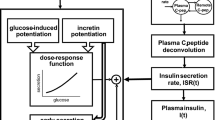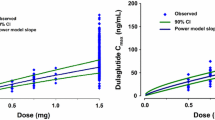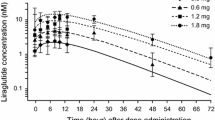Summary
We have studied the pharmacokinetics and pharmacodynamics of glyburide during long-term therapy in 20 patients with type II diabetes mellitus. The patients were divided according to body mass index (BMI) into an obese group [n=12, age 55(13) y, BMI 36.2(9.2) kg·m−2, total body weight (TBW) 100(23) kg], and a non-obese group [n=8, age 61(13) y, BMI 24.5(2.1) kg·m−2, TBW 73(7) kg].
The dosages of glyburide were titrated to achieve specified therapeutic goals based upon serum glucose concentrations or to a maximum dosage of 20 mg per day. The pharmacokinetics of glyburide were determined at week 12 of treatment. On the study day, the patients took a 2.5 mg liquid test dose of glyburide with a Sustacal meal challenge. The elimination rate constant (λz), clearance (CL), and apparent volume of distribution (Vz) were 0.08 h−1, 3.3 l·h−1, and 47.0 l in the obese group, and 0.07 h−1, 3.1 l·h−1, and 56.8 l in the non-obese group. These values were not statistically significantly different. However, there were differences between the groups when the volume and clearance were corrected by TBW or BMI but not by ideal body weight (IBW) or fat-free mass (FFM).
Regression analysis between the pharmacokinetic variables and body weight status revealed statistically significant correlations between volume or clearance and body weight. However, due to large inter-patient variability, these relations were relatively weak and were considered to be non-predictive.
In regard to the pharmacodynamic effects of glyburide, there were greater C-peptide and insulin responses at baseline and after 12 weeks of therapy in the obese than in the non-obese patients. However, there were no significant differences in glucose responses between the two groups. More non-obese patients needed the maximum dose (20 mg) of glyburide (7/8) compared with obese patients (6/12).
These findings suggest that obese patients may be more sensitive to the effects of glyburide. Alternatively, our obese patients may have had less serious disease than our non-obese patients.
Similar content being viewed by others
References
Abernethy DR, Greenblatt DJ (1986) Drug disposition in obese humans: an update. Clin Pharmacokinet 11: 199–213
Balant L (1981) Clinical pharmacokinetics of sulfonylurea hypoglycaemic drugs. Clin Pharmacokinet 6: 215–241
Balant L, Zahnd GR, Weber F, Fabre J (1977) Behavior of glibenclamide on repeated administration to diabetic patients. Eur J Clin Pharmacol 11: 19–25
Rogers HJ, Spector RG, Morrison PJ (1982) Pharmacokinetics of intravenous glibenclamide investigated by high-performance liquid chromatographic assay. Diabetologia 23: 37–40
Pearson JG (1985) Pharmacokinetics of glyburide. Am J Med 79: 67–71
Addison TE, Knuth DW, Hopkins NK, Brisson J (1990) Determination of glyburide in human serum and plasma by HPLC with deuterium source fluorescence detection. Pharm Res 7 [Suppl]: S8
Garrow JS, Webster J (1985) Quetelet's index(W/H2) as a measure of fatness. Int J Obesity 9: 147–153
Devine BJ (1974) Gentamicin therapy. Drug Intell Clin Pharm 8: 650–655
Defronzo RA, Ferrannini E (1991) Insulin resistance: a multifaceted syndrome responsible for NIDDM, obesity, hypertension, dyslipidemia, and atherosclerotic cardiovascular disease. Diabetes Care 14: 173–194
Kaplan NM (1989) The deadly quartet: upper-body obesity, glucose intolerance, hypertriglyceridemia, and hypertension. Arch Intern Med 149: 1514–1520
Author information
Authors and Affiliations
Rights and permissions
About this article
Cite this article
Jaber, L.A., Antal, E.J., Slaughter, R.L. et al. The pharmacokinetics and pharmacodynamics of 12 weeks of glyburide therapy in obese diabetics. Eur J Clin Pharmacol 45, 459–463 (1993). https://doi.org/10.1007/BF00315518
Received:
Accepted:
Issue Date:
DOI: https://doi.org/10.1007/BF00315518




